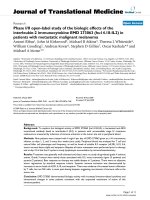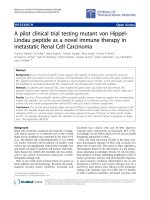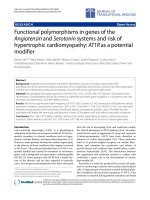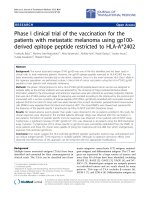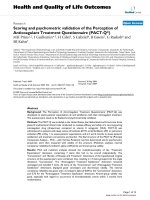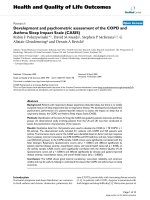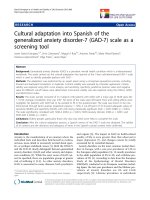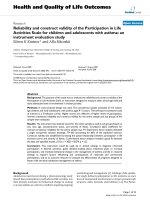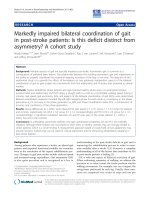Báo cáo hóa học: " Phase I clinical trial of the vaccination for the patients with metastatic melanoma using gp100derived epitope peptide " pot
Bạn đang xem bản rút gọn của tài liệu. Xem và tải ngay bản đầy đủ của tài liệu tại đây (1.6 MB, 12 trang )
RESEARC H Open Access
Phase I clinical trial of the vaccination for the
patients with metastatic melanoma using gp100-
derived epitope peptide restricted to HLA-A*2402
Toshiyuki Baba
1†
, Marimo Sato-Matsushita
1†
, Akira Kanamoto
1
, Akihiko Itoh
1
, Naoki Oyaizu
2
, Yusuke Inoue
3
,
Yutaka Kawakami
4
, Hideaki Tahara
1*
Abstract
Background: The tumor associated antigen (TAA) gp100 was one of the first identified and has been used in
clinical trials to treat melanoma patients. However, the gp100 epitope peptide restricted to HLA-A*2402 has not
been extensively examined clinically due to the ethnic variations. Since it is the most common HLA Class I allele in
the Japanese population, we performed a phase I clinical trial of cancer vaccination using the HLA-A*2402 gp100
peptide to treat patients wi th metastatic melanoma.
Methods: The phase I clinical protocol to test a HLA-A*2402 gp100 peptide-based cancer vaccine was designed to
evaluate safety as the primary endpoint and was approved by The University of Tokyo Institutional Review Board.
Information related to the immunologic and antitumor responses were also collected as secondary endpoints. Patients
that were HLA-A*2402 positive with stage IV melanoma were enrolled according to the criteria set by the protocol and
immunized with a vaccine consisting of epitope peptide (VYFFLPDHL, gp100-in4) emulsified with incomplete Freund’s
adjuvant (IFA) for the total of 4 times with two week intervals. Prior to each vaccination, peripheral blood mononuclear
cells (PBMCs) were separated from the blood and stored at -80°C. The stored PBMCs were thawed and examined for
the frequency of the peptide specific T lymphocytes by IFN-g- ELISPOT and MHC-Dextramer assays.
Results: No related adverse events greater than grade I were observed in the six patients enrolled in this study. No
clinical responses were observed in the enrolled patients although vitiligo was observed after the vaccination in
two patients. Promotion of peptide specific immune responses was observed in four patients with ELISPOT assay.
Furthermore, a significant increase of CD8
+
gp100-in4
+
CTLs was observed in all patients using the MHC-Dextramer
assay. Cytotoxic T lymphocytes (CTLs) clones specific to gp100-in4 were successfully establ ished from the PBMC of
some patients and these CTL clones were capable of lysing the melanoma cell line, 888 mel, which endogenously
expresses HLA-restricted gp100-in4.
Conclusion: Our results suggest this HLA-restricted gp100-in4 peptide vaccination protocol was well-tolerated and
can induce antigen-specific T-cell responses in multiple patients. Although no objecti ve anti-tumor effects were
observed, the effectiveness of this approach can be enhanced with the appropriate modifications.
Background
Multiple tumor associated antigens (TAAs) have been
identified and examined for their immunogenicity in
clinical trials. The TAAs can be classified into three
major categories: cancer/testis (CT) antigens, mutated-
gene antigens, and differentiation antigens. The CT anti-
gens are express ed by a large variety of tumors and
more than 40 of them have been identified, including
MAGE [1], BAGE [2], GAGE [3], XAGE [4], and NY-
ESO-1 [5]. Mutated-gene a ntigens are uniquely present
on individual tumors and are rarely shared by many
patients. This type of TAA includes b-catenin [6],
MUM-1 [7], and CDK-4 [8]. Differentiation antigens are
* Correspondence:
† Contributed equally
1
Department of Surgery and Bioengineering, Advanced Clinical Research
Center, Institute of Medical Science, The University of Tokyo, 4-6-1 Shirokane-
dai, Minato-city, Tokyo, 108-8639, Japan
Full list of author information is available at the end of the article
Baba et al. Journal of Translational Medicine 2010, 8:84
/>© 2010 Ba ba et al; licensee BioMed Central Ltd. This is an Open Access article distributed under the terms of the Creative Commons
Attribution License ( which permits unrestricted use, distribution, and reproduction in
any med ium, provided the original work is properly cite d.
expressed as molecules related to the cell differentiation
and have been found main ly in melanomas. These
TAAs include MART-1/MelanA [9,10], tyrosinase [11],
TRP-1(gp75) [12], and gp100/pMEL 17 [13,14].
The gp100 TAA is a melanocyte lineage-specific
membrane glycoprotein consisting of 661 amino acids,
categorized as a d ifferentiation Ag. It is expressed in
melanomas, but not in oth er tumor cell types or normal
cells with the exception of melanocytes and pigmented
cells in the retina. gp100 is recognized by antibodies
NKI-beteb, HMB-50 and HMB-45, which are used as
diagnostic markers for human melanoma [15]. The reac-
tivity of HMB-45 on formalin-fixed-embedded speci-
mens of malignant melanomas was shown to be
approximately 74-80% in large scale studies [16,17].
Thus, gp100 is expressed in most malignant melanomas.
Since HLA-A*0201 is prevalent in Caucasian popula-
tion, epitope peptides restricted to such alle le,
gp100:209-217 (ITQVPFSV) [18], and its modified form,
gp100:209-217(210M) (IMQVPFSV) which has been
modified to have increased binding affinity for HLA-
A*0201, have been examined for their immunogenicity
[19]. These studies have been shown that these peptides
can induce cytotoxic T lymphocytes (CTLs) that recog-
nize cells pulsed with native gp100:209-217 peptide as
well as the melanoma cells positive for HLA-A*0201
and gp100 [19]. In other clinical trials, HLA-A*0201-
positive melanoma patients were vaccinated with
gp100:209-21 7(210M) with incomplete fluid adjuvant
(IFA). In 10 of 11 patients vaccinated with this peptide
there was a significant increase in antigen-specific CTL-
precursors [20]. Furthermore, 13 of 31 patients treated
with gp100:209-217(210M) along with systemic adminis-
tration of high-dose IL-2 exhibited an objective cancer
response. Of these HLA-A*0201 restricted epitope pep-
tides derived from gp100, there are several reports
describing successful induction of anti-tumor CTLs in a
class I-restricted fashion [21,22]. Thus, epitope peptides
derived from gp100 appear to be promising Ags for
tumor-specific immunotherapy against malignant
melanoma.
In contrast to these HLA-A*0201-restricted peptides,
the gp100-derived epitope peptides restricted to HLA-
A*2402, which is the most common HLA class I allele
in the Japanese population [23,24], have not been exam-
ined extensively. However, it has been shown that mela-
noma-reactive CTLs established from the tumor-
infiltrating lymphocytes (TILs) of HLA-A*2402-positive
patients recognize a non-mutated peptide, encoded by
an aberrant transcript of the gp100 gene [25]. This tran-
script contains the fourth intron of the gp100 gene and
the CTL epitope is encoded within this region. The pep-
tide, termed gp100-in4 (VYFFLPDHL), was observed to
be expressed only at low levels, but the CTLs can
recognize very small amounts of the cell surface HLA/
peptide complex. In addition, gp100-in4 binds to HLA-
A*2402 with high affinity and thus might be very effi-
ciently processed and present on the melanoma and
melanocyte cell surface. The binding affinity of gp100-
in4 was predicted to be very high at the score of 240 .0,
when the analysis was performed with the computer-
based program for molecular analysis section (BIMAS)
for HLA peptide binding predictions [26]. Thus, gp100-
in4 might be the most promising epitope peptide among
the candidate peptides derivedfromgp100totreat
HLA-A*2402-positive melanoma patients.
We have conducted a phase I clinical trial to treat the
HLA-A*2402-positive patients with stage IV melanoma
by vaccination with the gp100-in4 peptide. In this study,
we examined the safety of this treatment as a primary
endpoint and the clinical and immunological responses
as secondary endpoints. For the immunological monitor-
ing, we employed both ELISPOT and MHC-Dextramer
assays. Furthermore, CTL cl ones specific to gp 100-in4
were established from peripheral blood mononuclear
cells (PBMCs) of the treated patients and analyzed for
their functions.
Methods
Patients
All patients were diagnosed to have stage-IV mela-
noma based on the American Joint Commission on
Cancer staging system and had received various treat-
ments prior to the entry of this pro tocol. These treat-
ments include surgery, chemotherapy, radiation
therapy, thermotherapy and immunotherapy, all of
which have failed prior to enrollment. Other eligibility
criteria included the age (20-75 years), HLA typing
(HLA-A*2402), existence of tumor lesions measurable
with CT or MRI, good performance status (0 to 2 in
the Criteria of Eastern Cooperative Oncology Group
(ECOG), adequate bone marrow , hepatic, and renal
functions (WBC >3000/mm
3
and <9000/mm
3
;AST
<50 U/ml; ALT <50 U/ml; serum bilirubin <1.1 mg/dl;
BUN <20 mg/dl; and creatinine <1.1 mg/dl). Patients
also were required to receive no treatment for the dis-
ease for four weeks prior to the initiation of the vacci-
nation and have no serious infection. Exclusion criteria
included having less than 3 months of expected survi-
val and receiving corticosteroids or immunosuppressive
drugs. Women who were pregnant and lactating also
were not eligible. All patients were gave written
informed consent to participate in the study according
to the Declaration of Helsinki and the study was
approved by the University ofTokyoInstituteofMedi-
cal Science IRB. Tumor responses to the treatment
were assessed according to Response evaluation criteria
in solid tumors (RECIST).
Baba et al. Journal of Translational Medicine 2010, 8:84
/>Page 2 of 12
Study design and treatments
The study was an open-label phase I study in patients
with advanced malignant melanoma to assess safety o f
the treatment. Immunological response and clinical
responses were examine d as secondary endpoints. The
enrolled patients were treated with a vaccine composed
of the gp100-derived epitop e peptide restricted to HLA-
A*2402 every two weeks for four times in total as one
course. Additional courses of the treatments were
allowed after having the approval of the case manage-
ment committee. The study protocol was a pproved by
Institutional Review Board (IRB) of the Institute of Med-
ical Science at the University of Tokyo and written
informed consent was obtained from all of the patients
at the time of enrollment.
Peptides
The gp100-in4 (VYFFLPDHL) [27], HLA-A*2402-res-
ticted epitope peptide derived from gp100, were used to
vaccinate HLA-A*2402 melanoma patients. The peptide
was purchased from Multiple Peptide Systems (San
Diego, CA) where it was synthesized under c urrent
good manufacturi ng practice conditions defined by US-
FDA. F or in vitro immunological monitoring, the HLA-
A*2402-restricted-CMV peptide (QYDPVAALF) was
used as a positive control and the HLA-A*2402-
restricted-HIV peptide (RYLRDQQLL) [27] was used as
a negative control. The HIV and CMV peptides were
synthesized by Dr. Shinobu Ohmi (Division of Cell Biol-
ogy and Biochemistry, Department of Basic Medical
Science, Institute of Medical Science, The University of
Tokyo).
Vaccination
The enrolled patients were injected subcutaneou sly with
1 mg of the gp100-in4 emulsified in 1 ml of IFA (Mon-
tanide ISA-51, Seppic, France) into the skin at the axil-
lary or inguinal region. Four vaccinations with gp100-
in4 were give n at two week intervals in one course. A
physical examination, blood cell counts and standard
blood tests were performed prior to each vaccination
and 2 weeks after the last vaccination.
Peripheral blood samples
The50mlofperipheralbloodwasdrawnfromthe
enrolled patients before each vaccination and 2 weeks
after the last vaccination for the immunological moni-
toring. Drawn blood was heparinized, prepared for
PBMCs with Ficoll-Paque (Amersham Biosci ences, Pis-
cataway, NJ) gradient centrifugation, and suspended in
heat-inactivated human AB serum (MP Biomedicals,
Irvine, CA) with 10% D MSO (Wako Pure Chemical
industr ies, Ltd., Osaka, Japan), for cryopreservati on in a
liquid nitrogen freezer at -180°C.
Cell lines
The A24-LCL, a human B-lymphoblastoid cell line
(B-LCL) which expresses the HLA-A24 allele, was
pulsed with peptides and used for a stimulator or target
in cytotoxicity assay. An Epstein-Barr virus-transformed
B-lymphoblastoid cell line, EHM (HLA-A03/03), was
used for the expansion of CTLs. These cell lines were
cultured in RPMI1640 medium (GIBCO, Grand Island,
NY) containing 100 U/ml of penicillin, 100 mg/ml of
streptomycin (GIBCO), and 10% heat-inactivated fetal
bovine serum (FBS) (Sigma Diagnostics, St. Louis, MO).
A colon adenocarcinoma cell line, HT29 (HLA-A1/
A24) purchased from American Type Culture Coll ection
(ATCC; Manassas, VA), and melanoma cell lines, 888
mel (HLA-A1/A24) and 397 mel (HLA-A1/A25) estab-
lished [28], were maintained in Dulbecco’ smodified
Eagle’s medium (GIBCO) supplemented with 100 U/ml
of penicillin, 100 mg/ml of streptomycin, and 10% heat-
inactivated FBS. They were used as targets to examine
the cytotoxicity of CTLs raised f rom the patients’
PBMC.
Cell culture for immunological assays
The cryopreserved PBMCs of the patients were thawed
and susp ended at the density of 1 × 10
7
cells per 15 ml
tube (Falcon) in 10 ml with RPMI1640 medium supple-
mented with 10% FBS, 100 mg/ml streptomycin, 100
IU/ml penicillin, and 5 × 10
-5
M 2-mercaptoethanol (all
from Invitrogen Life Technologies), referred to hence-
forth as complete medium. After rinsing the cells twice
with the complete medium, 1 × 10
6
of PBMCs were cul-
turedinthe2mlofcompletemediumsupplemented
with recombinant human (rh) IL-2 (20 U/ml) containing
10 μg/ml of either the gp100-in4 peptide, HIV peptide
(a negative control), or CMV peptide (a positive control)
using 5 ml round bottom tubes (BD). To ensure better
sensitivity and specificity for each assay, ELISPOT and
the MHC-Dextramer assays were performed after 4 and
8 days of culture.
Cytokine-specific Enzyme-Linked Immuno-spot assay
The patient s’ PBMCs were cultured for 4 days as
described above and the IFN-g- producing cells detected
using 96-well nitrocellulose base plates of ELISPOT
assay kits (BD™ ELISPOT Research Products, BD Phar-
mingen) according to the manufacturer’s instructions.
Briefly, cultured cells were placed at a density of 5 × 10
4
cells per well in co mplete medium with 10 μg/ml of
either the gp100-in4, HIV (a negative control), or CMV
(a positive control) peptide in pre-coated BD™ ELISPOT
plates for 48 hours under conditions of 37°C and 7.5%
CO
2
. Spots were developed using b iotinylated detection
antibody for anti-IFN-g antibody, streptavidin-HRP,
AEC substrate solution. Frequencies of antigen-specific
Baba et al. Journal of Translational Medicine 2010, 8:84
/>Page 3 of 12
spot-forming cells were measured with C. T. L. Immu-
nospot analyzer and software (Cellular Technologies,
Cleveland, OH). Every experiment was performed in
quadruplicate.
MHC-Dextramer analysis
The MHC-Dextramers holding epitope peptides of
gp100 (gp100-in4) or HIV (a n egative control) were
synthesized by Dako Japan Inc. (Tokyo, Japan) and
used according to the instruction. 1 × 10
6
cells were
cultured for 8 days as described above and stained
with 10 μl of PE-conjugated MHC-Dextramers for 20
min in the dark at room temperature. All samples then
were incubated with 7AAD, APC-conjugated anti-CD3
mAb and FITC-conjugated anti-CD8 mAb in the con-
dition recommended by the manufacturer (BD Phar-
mingen) for 30 min at 4°C in the dark. Flow
cytometric measurements were performed using a
FACS Calibur (BD Bioscience) and analyzed using BD
CellQuest Pro (BD Biosciences).
Establishment of CTL clones
CTL clones were generated following a method
described previously with minor modificat ions [29].
Patients’ PBMCs were stimulated in culture with the
gp100-in4 peptide, and the cells capable of producing
IFN-g at the levels higher than those with HIV peptide
(a negative control) were selected and plated in 96-
well round bottom plates at 0.3, 1, and 3 cells per well
with 8 × 10
4
g-irradiated (3.3 Gy) allogenic PBMCs
and 1 × 10
4
g-irradiated (8 Gy) EHM in 150 μlof
AIM-V medium containing 5% heat-inactivated human
AB serum, 30 ng/ml of anti-CD3 MAb (PharMingen),
and 125 IU/ml of rhIL-2 (Teceleukin, Biogen, Inc.
Cambridge, MA). Ten days after the stimulation, 50 μl
of culture medium containing 500 IU/ml of rhIL-2 w as
added to each well of the culture. On d ay 14, the cyto-
toxic activity of each cultur e was tested against A24-
LCL cells pulsed with either the corresponding peptide
or HIV peptide using a
51
Cr release assay. The CTLs
with peptide-specific cytotoxic activities were expanded
to characterize their functions in detail [30-32]. The 5
×10
4
of selected CTLs were suspended in 25 ml of
AIM-V medium containing 5% heat-inactivated human
AB serum and 30 ng/ml of anti-CD3 mAb and co-cul-
tured with 2.5 × 10
7
g-irradiated allogenic PBMCs and
5×10
6
g-i rradiated EHM in a 25 cm
2
Flask (BD Bio-
sciences). One day post-initiation of the culture,
120 IU/ml of rhIL-2 was added to the well. The cul-
tures were supplemented with fresh A IM-V medium
containing 5% heat-inactivated human AB serum and
30 IU/ml of rhIL-2 on days 5, 8, and 11. On average,
approximately 1-2 × 10
7
cells were established as CTL
clones by day 14 of the culture.
Cytotoxicity assays
Cytotoxicity was measured using a standard 4-h
51
Cr-
release assay. The A24-LCL cells were pulsed with 20
μg/ml of either the corresponding peptide or HIV pep-
tide in 10 ml of AIM-V medium overnight and used as
targets in cytotoxicity assays. The peptide-pulsed A24-
LCL cells and the cancer cell lines (888 mel, 397 mel,
and HT29) were labeled with 100 μCi of
51
Cr for
1hourat37°C.Labeledtargetcells(1×10
4
in 100 μl/
well) were placed into u-bottom-type 96-well micro-
culture plates, and the CTL clones, in 100 μ of media,
were added to each well as effecter cells to achieve the
E/T ratios indicated in the figures. Each assay was per-
formed in duplicate. The supernatants were harvested
after 4 hours of incubation, and radioactivity was m ea-
sured with a g-co unter. Percen t specific lysis was cal-
culated as follows: % specific lysis = [(experimental
lysis - minimal lysis)/(maximal release - minimal
release)] ×100. Minimal lysis was obtained by i ncubat-
ing the target cells with the culture medium alone, and
maximal lysis was obtained by exposing the target cells
to 1N HCl. In some cy totoxicity assays, target or effec-
ter cells were incubated with blocking Abs as pre-
treatments to examine the characteristics of CTLs as
described elsewhere [30-32]. These pre-treatments
include the incubation of
51
Cr-labeled 888 mel tumor
cells or CTLs with anti-HLA class I mAb, anti-HLA
Class II mAb, IgG1, or IgG2a, or with anti-CD4 mAb,
anti-CD8 mAb, or IgG1 for 30 min at 4°C, respectively.
Then, pre-treated effectors and targets were mixed at
an E/T ratio of 30 and cytotoxicity examined as
described above. Percent inhibition was determined
using the following formula: [(% specific lysis of inhibi-
tion by isot ype control) - (% specific lysis of inhibition
by MAb)]/(% specific lysis of inhibition by isotype
control) × 100. All mAb was purchased from Dako
Japan Inc.
Immuno-histochemical analysis
Biopsy specimens we re taken f rom some of vaccinated
patients with written informed consent. Serial sections
of paraffin-embedded tissues were made and stained
with H&E, S100 (Polyclonal r abbit anti-S100, Dako
Japan Inc), or monoclonal antibodies against CD3, CD4
(Novocastra Laboratories Ltd, Newcastle upon Tyne,
UK), and CD8 (Dako) according to the manufacturers’
instructions.
Results
Patient characteristics
The characteristics of the HLA-A*2402-positive patients
with stage IV melanoma enrolled in this trial (P1-P6)
are shown in Table 1. All patients had a score of 0-1 in
the performance status scale defined by ECOG. All
Baba et al. Journal of Translational Medicine 2010, 8:84
/>Page 4 of 12
patients had received other therapies including surgery,
chemotherapy, and radiati on therapy prior to t he enrol-
lment. Four male and two female patients with a median
age of 55 (range, 35-74 years) were enrolled.
Adverse events
The adverse event s observed in all the patients enrol led
in this trial are listed in Table 2. Grade III non-hemato-
logical adverse events were observed in P1 (CNS hemor-
rhage at the brain metastasis) and P4 (hypoxia), and
grade III hematological adverse events were observed in
P2 (anemia). However, all these events were judged to
be not related to the treatmen t, but due to the progress
of the disease. Transient dermatologic toxicities such as
induration, rubor, local pain, and itching were observed
in all patients at the injection sites (grade I toxicity). P2
(Fig.1A) and P3 (F ig.1B) developed vitiligo during the
1st course of vaccination. These results suggest that
gp100 peptide-based vaccines was well-tolerated by the
enrolled patients.
Clinical anti-tumor responses
Table 2 shows the summary of the clinical observations
of the enrolled patients. Two patients received one
course of vaccination and three received two or more
courses. P5 withdrew after two vaccinations in the 1st
course due to the rapid tumor progression. All the
patients enrolled in this protocol were judged to have
progressive disease (PD) after the first course of treat-
ment and at final evaluation.
Immunohistochemical analysis of vitiligo
As described in “ Adverse events”, two patients were
found to have vitiligo throughout the body. These
adverse events might be associated with the vaccination,
since gp100 is also expressed by the non-cancerous mel-
anocytes. The Fig. 1A shows vitiligo at the posterior
portion of the neck i n P2, and Fig. 1B showed vitiligo at
the anterior tibial portion of the left leg in P3. The serial
sections were made from tissue samples taken from the
vitiligo of P2 and examined with H&E and immuno-
histochemical staining (F ig. 2). The infiltration of CD3
+
T-cells was observed at the epidermis with de-pigmenta-
tion (Fig. 2A and 2B). These infiltrating T-cells mainly
consisted of CD4
+
T-cells rather than CD8
+
T-cells (Fig.
2C). Interestingly, the S100-positive cells, compatible
with a dendritic cell phenotype, accumulated in the
same area (Fig. 2D). These findings suggest that the viti-
ligo is associated with the immunological responses pro-
moted by the vaccination against gp100.
Immunological monitoring for peptide specific T-cell
responses in enrolled patients
As described in Methods, PBMCs obtained from the
enrolled patients were examined with ELISPOT and
MHC-Dextramer assay after the short-term culture. The
results of the ELISPOT and the MHC-Dextramer assay
are shown in the left and light panel for each patient in
Fig. 3, respectively. In ELISPOT assay (Table 3), the
responses of the patien ts were evaluated as ++ (strongly
positive) if the num bers of IFN-g positive spots after the
Table 1 Clinical profiles of enrolled patients
Patients Age Sex Primary sites Sites of metastases Stage PS Previous Tx
P1 41 female Skin (back) Liver, Spleen, Skin IV 0 S/C
P2 74 female Skin (knee) Lymph nodes IV 0 S/C
P3 58 male Ocular Liver, Stomach IV 0 S/C
P4 69 male Skin (chest) Lung, Liver IV 1 S/C
P5 35 male Ocular Liver IV 0 R/C
P6 52 male Nasal cavity Lymph node, Skin IV 0 R
The six HLA-A*2402-positive patients with stage IV melanoma initially enrolled in this clinical trial are shown in this table. All patients had relatively good
performance status (PS) and had previously undergone treatments (Tx), for example surgery (S), chemotherapy (C), and radiation therapy (R).
Table 2 Clinical observations on enrolled patients
Patients Times of vaccination (course) Follow-up Adverse events Clinical anti-tumor responses Vitiligo
After 1 course Final
P1 12 (3) 13 months Induration, Rubor, Itching, CNS hemorrhage* PD PD None
P2 8 (2) 8 months Induration, Rubor, vitiligo, Anemia* PD PD +
P3 8 (2) 7 months Induration, Rubor, Local pain, vitiligo PD PD +
P4 4 (1) 2 months Induration, Hypoxia* PD PD None
P5 2 (1) 1 month Rubor, Pyrexia incomplete ( - ) None
P6 4 (1) 4 months Rubor PD PD None
The results of this clinical trial for six patients individually are summarized in this table. P1 showed evidence of an anti-tumor effect. Vitiligo appeared in two
patients (P2 and P3) throughout the body. Both anti-tumor effect and vitiligo were defined as the clinical and immunological responses.
Baba et al. Journal of Translational Medicine 2010, 8:84
/>Page 5 of 12
Figure 1 Vitiligo in patient P2 and P3. Vitiligo appeared throughout the body during the 1st course of vaccination in P2 and P3.
Representative finding of vitiligo was observed in the posterior portion of the neck in P2 (A) and the anterior tibial portion of the left leg in
patient P3 (B).
Figure 2 Immuno histochemical analysis of vitiligo. Biopsy specimens of the area with vitiligo in P2 were stained with H&E to identify
infiltrating cells. This focus was a match for vitiligo. To characterize the nature of infiltrating lymphocytes and DCs, biopsy specimens were
stained for cell surface markers that were antibodies against CD3, CD4, CD8 and S100. Marked lymphocytes infiltrated into epidermis with
depigmentation of biopsy specimen stained with H&E (3A: arrow head). Immunohistochemical analysis revealed that CD3
+
T-cells infiltrated at
the same sites (3B) and composed of CD4
+
T-cells (3C: arrow, brown) and CD8
+
T-cells (3C: arrow head, purple). Interestingly, DCs stained with
S100 also accumulated at the same sites (3D).
Baba et al. Journal of Translational Medicine 2010, 8:84
/>Page 6 of 12
vaccinations increased more than two fold compared
with the numbers at pre-vaccination. If the increments
were in between one to two fold, they were evaluated as
+ (marginally positive). These assays were performed at
least three times to confir m reproducib ility. To evaluate
the characteristics of the peptide-specific CTLs, PBMCs
of the patients were stimulated in vitro with e ither the
gp100-in4, HIV or CMV peptide and examined for their
ability to produce IFN-g.IFN-g-producing cells were
induced with the gp100-in4 stimulation on the PBMCs
taken from the patients (P1, P2, P3, and P4) after the
vaccination. The PBMCs of P1 showed an incremental
increase in the frequency of induced IFN-g-producing
cells in association with the number of the vaccinations.
In P2, a significant increase of the frequency of induc-
tion of IFN-g-producing cells was observed during the
Figure 3 Immunological monitoring for peptide specific T-cell responses in melanoma patients using ELISPOT and MHC-Dextramer
assay ELISPOT and the MHC-Dextramer assay are shown in the left (a, e, i, c, g and k) and right (b, f, j, d, h and l) side of each panel. The arrow
indicates the timing of each vaccine injection. In ELISPOT assay, to evaluate the characteristics of peptide-specific CTLs, PBMCs of the patients
were stimulated in vitro with gp100-in4, HIV or CMV peptide (data not shown) and examined for their ability to produce IFN-g. The MHC-
Dextramer assay was performed on blood samples identical to the ones used for ELISPOT assay to identify CD8
+
T-cells recognizing the epitope
peptide used. For flow cytometric analysis, PBMCs, which were stimulated in vitro, were stained with the MHC-Dextramer for 20 min in the dark
at room temperature, followed by staining with FITC-conjugated anti-CD8 mAb and APC-conjugated anti-CD3 mAb and 7AAD (Beckton
Dickinson Biosciences) at 4°C for 30 min. Flow cytometric analysis was performed using FACSCalibur and CellQuest software (BD Biosciences).
Table 3 The results of immunological monitoring
Patients Times of vaccination (Course) Follow-up ELISPOT assay (IFN-g) Dextramer assay (The frequency of peptide specific CTLs)
P1 12 (3) 13 months ++ +
P2 8 (2) 8 months ++ ++
P3 8 (2) 7 months + ++
P4 4 (1) 2 months ++ +
P5 2 (1) 1 month - ++
P6 4 (1) 4 months - +
The characteristics of patients exhibiting objective immunological responses. In ELISPOT assay, the responses of the patients were evaluated as ++ (strongly
positive), if the numbers of IFN-g positive spots after the vaccinations increased more than two fold when compared with the numbers at pre-vaccination. If the
increase was in between one to two fold, they were evaluated as + (marginally positive). These assays were performed at least three times to confirm
reproducibility.
Baba et al. Journal of Translational Medicine 2010, 8:84
/>Page 7 of 12
first course of the treatment. However, the frequency
decreased soon after the first course of vaccination, but
increased again with the second course of vaccination.
In P3 and P4, IFN-g-producing cells with significant spe-
cific reactivity to g p100-in4 were detected post vaccina-
tion, but at low levels. In contrast, IFN-g-producing cells
were not identified in the PBMCs taken from patients
P5 and P6 even after vaccinations. P5 was withdrawn
from the protocol due to the disease progression during
the first course of the treatment.
The MHC-Dextramer assay was performed on blood
samples identical to the ones used for ELISPOT assay to
identify the CD8-positive T-cells recognizing the epitope
peptide. The results of the MHC-Dextramer assay are
shown in Fig. 3. The freq uency of CTLs speci fic for the
gp100-in4 peptide was elevated two to eight times when
compared with the pre-vaccination levels. In addition,
the frequencies of the cells positive for both CD8
+
and
HLA-A*2402/gp100-in4 Dextramer were higher than
that at pre-vaccination. If the increases were more than
2-fold, they were evaluated as ++ (Table 3). All patients
were judged to have positive responses.
Establishment of gp100-specific CTL clones
CTL clones were generated from the patients’ PBMCs as
described above. One CTL clone from P2, three CTL
clones from P3, and one clone from P4 were established
from the P BMCs taken a fter the vaccination. No CTL
clone was successfully e stablished from the PBMCs
taken before the vaccinations. A standard 4 h
51
Cr-
release assay was employed to confirm the cytotoxicity
of these four CTL clones. Representative results of the
cytotoxicity assay of all the CTL clones established from
patient P2, P3 and P4 (P2-1, P3-1, P3-2, P3-3 and P4-1)
areshowninFig.4.AlltheCTLcloneswereableto
lyse A24-LCL target cells pulsed with gp100-in4 peptide,
but not those pulsed with HIV peptide. These CTL
clones also were able to lyse 888 mel, which naturally
express gp100 [gp100 (+), HLA-A24 (+)], but were
unable to lyse 397 mel [gp100 (+), HLA-A24 (-)] or
HT29 [gp100 (-), HLA-A24 (+)]. These data provide evi-
dence that the clones were gp100-specific. Similar
results were obtained with other CTL c lones from
patient P2 (1 clone), P3 (2 clones) , and P4 (1 clone). All
the CTL clones were tested for the expression of the T-
cell receptors binding to the HLA/peptide complex
using the HLA-A*2402/gp100-in4 D extramer. Similar
results also were obtained from gp100-specific CTL
clones established from P3.
Inhibition of the specific cytotoxic reactivity with HLA-
class I and CD8 monoclonal antibodies (mAbs)
To determine the involvement of HLA molecul es and
T-cell receptors in the recognition of antigen by the
gp100-in4-reactive CTL clones, the ability of anti-class I
mAb, anti-class II mAb, anti-CD4 mAb, and anti-CD8
mAb to inhibit the cytolytic activity of P3-2 and P3-3
established from gp100-in4-stimulated PBMCs of P3
was examined. The cytotoxicity of the CTL clones
against 888 mel was significantly reduced with anti-class
I mAb and anti-CD8 mAb. These results suggest that
the CTL clones recogni ze the gp100-derived epitopes in
an HLA class I-restricted manner (Fig. 5).
Discussion
A phase I clinical trial was performed using an HLA-
A*2402-restricted epitope-peptide derived from gp100 to
examine its safety as a primary endpoint and clinical
and immunological responses as secondary endpoints.
Six patients with stage IV melanoma were imm unized
with a vaccine consisting of the epitope peptide emuls i-
fied with IFA.
In two patients, grade III adverse events ( hematologi-
cal and non-hematological) were observed. These events
were examined in detail by the members of the IRB,
independent of the study group, and judged not to b e
related to the vaccination, but to the progress of the dis-
ease. Some t reatment-related adverse events were
observed, but none were judged to be greater than
Grade I. Thus, this treatment appears to be tolerated by
this type of patients.
No objective anti-tumor effects, defined by RECIST
criteria, were observed in any of the enrolled patients in
the present study. Des pite the fact that no significant
therapeutic effects were obtained with this treatment,
gp100-in4-specific T cell responses were observed in the
PBMCs taken from some of the enrolled patients post-
vaccination. In P1, P2, P3 and P4, an increase in the fre-
quency of IFN-g-producing cells was detected with the
peptide-specific ELISPOT assay. With the MHC-Dextra-
mer assay, which can detect the T-cell receptor capable
of binding specifically to the gp100-in4 peptide pre-
sented on a particular MHC molecule, an increase in
frequency of T-cells with the gp-100-specific T-cell
receptor was observed in all patients after the initiation
of vaccination. These results suggest that the vaccination
with gp100-derived peptide can frequently induce pep-
tide-specific CTLs in the peripheral blood, even in the
patients with advanced melanoma treated with multiple
modalities. Thus, this pep tide could be used as a n anti-
gen to initiate the immune response against certain
tumors, at least in the peripheral blood, similar to stu-
dies performed with other epitope peptides [33-39].
Interestingly, P2 and P3 were found to have new viti-
ligo, which appears to be c orrelated to the anti-tumor
immune responses [40], after the initiation o f the treat-
ment. Although the events were recorded as adverse
events in this protocol, this observation might be
Baba et al. Journal of Translational Medicine 2010, 8:84
/>Page 8 of 12
Figure 4 Establishment of gp100-specific CTL clones. The gp100-specific CTL clones were established in P2 and P3. Peptide-stimulated
PBMCs with the ability to produce IFN-g were expanded in the presence of feeder cells to establish gp100-specific CTL clones. Six clones were
established (1 clone for P2, 3 clones for P3, and 2 clones for P4). A standard 4 h
51
Cr-release assay was employed to confirm the anti-tumor
response of these six clones. Representative results of the clones established from mP3 (P3-2, P3-3) are shown in the figure. All CTL clones were
able to lyse A24-LCLs target cells pulsed with gp100-in4 (●), but not those pulsed with HLA-A*2402-resticted HIV peptide (□) in the left lane.
They also were able to lyse 888 mel naturally expressing gp100 [gp100 (+), HLA-A24(+)]: (●) but not to lyse 397 mel [gp100 (+), HLA-A24(-)]:
(□) and HT29 [gp100 (-), HLA-A24(+)]: (□).
Baba et al. Journal of Translational Medicine 2010, 8:84
/>Page 9 of 12
associated with the immune responses observed against
the gp100 peptide in peripheral blood. To address this
question, the skin tissue specimens with vitiligo were
taken from the P2 after the 1st course of the vaccination
with written consent. Morphological and immuno-histo-
chemical examination of the specimen showed that
there was an infiltration of inflammatory cells at the epi-
dermis corresponding to the vitiligo. The infiltrating
cell s were found to be CD3
+
T-cells, which mainly con-
sisted of CD4
+
T-cells rather than CD8
+
T-cells. In
addition, there were numerous cells compatible to den-
dritic cells in morphology and positive for S100 staining.
These findings might suggest that the vitiligo might
have emerged as a consequence of the attack by the
CTLs specific to gp-100 [41]. The dendritic cells might
have accumulated to the site of immune response,
engulfed resulting damaged cells, and induced the pro-
motion of CD4
+
T-cell s, which cannot recognize class I
restricted peptide, but can recognize the melanocyte
antigens presented on MHC-class II [42]. T hese obser-
vations on vitiligo also may suggest that the C TLs
detected with the immune monitoring in the peripheral
blood might have functional cytotoxic activity [43-45].
Itisimportanttonotethatnoclinicaltumor
responses were noted even in the patients with vitili go.
These results suggest that tumor cells were not effi-
ciently attached by the antigen-spec ific T-cells success-
fully induced with the vaccination through the multiple
mechanisms sugge sted elsewhere [46-51]. In this regard,
the discr epancies between the r esul ts of ELISPOT assay
and the MHC Dextramer assay in some patients (P5
and P6) suggest the existence of the mechanisms to sup-
press the immune functions. In these patients, the dex-
tramer-positive CTLs were observed, but the ELISPOT
assays showed negative results. It might mean that CTLs
with T-cell receptors recognizing the epitope peptide
might not be functionally active in these patients.
Although we have examined the frequency of regulatory
T-cells in CD4-positive cells of PBLs obtained from all
the enrolled patients, no significant tendencies were
found (data not shown). Further examinations, especially
on the tumor micro-environment, might yield more
definitive insights. In order to overcome these emerging
obstacles, multiple strategies including the co-adminis-
tration of high dose IL-2 and anti-CTLA-4 antibodies
with vaccine have been propose d for the clinical studies
[52,53]. Approaches to recruit CTLs to the tumor site
and to facilitate the CTL functions at the tumor site
would need to be developed to increase the therapeutic
potency of the cancer vaccine.
Conclusions
The peptide vaccine consisting of HLA-A*2402-
restricted epitope peptide derivedfromgp100andIFA
was safely administered to the stage IV melanoma
patients in this phase I trial. Although no therapeutic
effects of this treatment were observed in the enro lled
patients, immunologic monitoring of the treated patients
clearly showed that this vaccine is capable of initiating
immune responses against the melanoma. Thus the
further development of this agent to be used as an
immunogenic antigen in vaccine related therapies
against melanoma is warranted.
Abbreviations
ALT: alanine aminotransferase; AST: aspartate aminotransferase; APC: allo-
phycocyanin; BUN: blood urea nitrogen; CMV: cytomegalovirus; CT:
computed tomography; cytomegalovirus; ELISPOT: enzyme-linked
immunospot; FITC: fluorescein isothiocyanate; H&E: Hematoxylin and eosin;
HIV: human immunodeficiency virus; IL: interleukin; mAb: monoclonal
antibody; MRI: magnetic resonance imaging; PE: phycoerythrin; WBC: white
blood cell
Acknowledgements
We thank Dr. Fumitaka Nagamura (Division of Clinical Trial Safety
Management, Research Hospital, the Institute of Medical Science, the
University of Tokyo, Tokyo Japan) for his helpful suggestions on writing the
protocol and monitoring on the patients, Dr. Shinichi Asabe for his help
(Immunology Division and Division of Molecular Virology, Jichi Medical
School, Tochigi, Japan), and Ms Setsuko Nakayama, Ms Asuka Asami and Ms
Ruriko Miyake for their expert technical assistance (Department of Surgery
and Bioengineering, Advanced Clinical Research Center, Institute of Medical
Science, University of Tokyo). We also thank Dr. Paul D. Robbins (Professor of
Department of Molecular Genetics and Biochemistry, University of Pittsburgh
School of Medicine) for copyediting the manuscript.
Figure 5 Inhibition of the specific reactivity by mAb of HLA-
class I and CD8. The specific reactivity of CD8
+
T-cells was
inhibited by mAb of HLA-class I and CD8.
51
Cr-labeled 888 mel
[gp100 (+), HLA-A24 (+)] pre-incubated with anti-class I MAb, anti-
class II mAb, or a gp100-specific CTL clones (P3-2 or P3-3) were
incubated with anti-CD4 mAb or anti-CD8 mAb for 1 hour at 4°C.
After this time, effectors and target cells were mixed at an E/T ratio
of 30 and cytotoxicity was determined after 4 hours incubation at
37°C. The cytotoxicity of the CTL clone against 888 mel was
significantly reduced by the anti-class I and anti-CD8 mAbs.
Baba et al. Journal of Translational Medicine 2010, 8:84
/>Page 10 of 12
Author details
1
Department of Surgery and Bioengineering, Advanced Clinical Research
Center, Institute of Medical Science, The University of Tokyo, 4-6-1 Shirokane-
dai, Minato-city, Tokyo, 108-8639, Japan.
2
Department of Pathology and
Laboratory Medicine, Institute of Medical Science, The University of Tokyo, 4-
6-1 Shirokane-dai, Minato-city, Tokyo, 108-8639, Japan.
3
Department of
Radiology of Research Hospital, Institute of Medical Science, The University
of Tokyo, 4-6-1 Shirokane-dai, Minato-city, Tokyo, 108-8639, Japan.
4
Division
of Cellular Signaling, Institute for Advanced Medical Research, Keio
University, School of Medicine, 35 Shinano-machi, Shinjuku-city, Tokyo 160-
8582, Japan.
Authors’ contributions
TB and MSM conceived and coordinated the study, carried out
immunological assay and data analysis. MSM wrote the draft of the
manuscript. HT participated in the design of the study, and carried out the
clinical research. AK, AI, NO, YI participated in the conduct and data
management of the clinical protocol. YK provided information regarding the
gp-100 peptide and assisted in the interpretation of immunological assays.
HT provided general supervision and helped to draft and edited the
manuscript. All authors read and approved the final manuscript.
Competing interests
The authors declare that they have no competing interests.
Received: 21 May 2010 Accepted: 16 September 2010
Published: 16 September 2010
References
1. van der Bruggen P, Traversari C, Chomez P, Lurquin C, De Plaen E, Van den
Eynde B, Knuth A, Boon T: A gene encoding an antigen recognized by
cytolytic T lymphocytes on human melanoma. Science 1991,
254:1643-1647.
2. Gaugler B, Van Den Eynde B, Van der Bruggen P, Romero P, Gaforio JJ, De
Plaen E, Lethe B, Brasseur F, Boon T: Human gene MAGE-3 codes for an
antigen recognized on the melanoma by autologous cytolytic T
lymphocytes. J Exp Med 1994, 179:921-930.
3. Boel P, Wildmann C, Sensi ML, Brasseur R, Renauld JC, Coulie P, Boon T, Van
der Bruggen P: BAGE: a new gene encoding an antigen recognized on
human melanomas by cytolytic T lymphocytes. Immunity 1995, 2:167-175.
4. Brinkmann U, Vasmatzis G, Lee B, Pasten I: Novel genes in the PAGE and
GAGE family of tumor antigens found by homology walking in the
dbEST database. Cancer Res 1999, 59:1445-1448.
5. Chen YT, Scanlan MJ, Sahin U, Tureci O, Gure AO, Tsang S, Williamso B,
Stockert E, Pfreundschuh M, Old LJ: A testicular antigen aberrantly
expressed in human cancers detected by autologous antibody
screening. Proc Natl Acad Sci USA 1997, 94:1914-1918.
6. Robbbins PF, Ei-Gamil M, Li YF, kawakami Y, Loftus D, Appella E,
Rosenberg SA: A mutated b-catenin gene encodes a gp100-specific
antigen recognized by tumor infiltrating lymphocytes. J Exp Med 1994,
183:1185-1192.
7. Coulie PG, Lehmann F, Lethe B, Herman J, Lurquin C, Andrawiss M, Boon T:
A mutated intron sequence codes for an antigenic peptide recognized
by cytolytic T lymphocytes on a human melanoma. Proc Natl Acad Sci
USA 1995, 92:7976-7980.
8. Wolfel T, Hauer M, Schneider J, Serrano M, Wolfel C, Klehmann-Hieb E, De
Plaen E, Hankeln T, Meyer zum Buschenfelde KH, Beach D: A p16INK4a-
insensitive CDK4 mutant targeted by cytolytic T lymphocytes in a
human melanoma. Science 1995, 269:1281-1284.
9. Coulie PG, Brichard V, Van Pel A, Wolfel T, Schneider J, Traversari C, De
Plaen E, Lurquin C, Szikora JP, Renauld JC, Boon T: A new gene encoding
for a differentiation antigen recognized by autologous cytolytic T
lymphocytes on HLA-A2 melanomas. J Exp Med 1994, 180:35-42.
10. Kawakami Y, Eliyahu S, Delgado CH, Robbins PF, Rivoltini L, Topalian SL,
Miki T, Rosenberg SA: Cloning of the gene coding for a shared human
melanoma antigen recognized by autologous T cells infiltrating into
tumor. Proc Natl Acad Sci USA 1994, 91:3515-3519.
11. Brichard V, Van Pel A, Wolfel T, Wolfel C, De Plaen E, Lethe B, Coulie P,
Boon T: The tyrosinase gene codes for an antigen recognized by
autologous cytolytic T lymphocytes on HLA-A2melanoma. J Exp Med
1993, 178:489-495.
12. Wang RF, Robbins PF, Kawakami Y, Kang XQ, Rosenberg SA: Identification
of a gene encoding a melanoma tumor antigen recognized by HLA-
A31-restricted tumor-infiltrating lymphocytes. J Exp Med 1995,
181:799-804.
13. Bakker AB, Schreurs MW, de Boer AJ, Kawakami Y, Rosenberg SA, Adema GJ,
Figdor CG: Melanocyte lineage-specific antigen gp100 is recognized by
melanoma-derived tumor-infiltrating lymphocytes. J Exp Med 1994,
179:1005-1009.
14. Kawakami Y, Eliyahu S, Delgado CH, Robbins PF, Sakaguchi K, Appella E,
Yannelli JR, Adema GJ, miki T, Rosenberg SA: Identification of a human
melanoma antigen recognized by tumor-infiltrating lymphocytes
associated with in vivo tumor regection. Proc Natl Acad Sci USA 1994,
91:6458-6462.
15. Henderson RA, Finn OJ: Human tumor antigens are ready to fly. Adv
Immunol 1996, 62:217-256.
16. Cormier JN, Hijazi YM, Abati A, Fetsch P, Bettinotti M, Steunberg SM,
Rosenberg SA, Marincola FM: Heterogenous expression of melanoma-
associated antigens and HLA-A2 in metastatic melanoma in vivo. Int J
Cancer 1998, 75:517-524.
17. Jungbluth A, Busam K, Gerald W, Stockert E, Coplan K, Iversen K,
MacGregor D, Old L, Chen YT: An anti-Melan-A monoclonal antibody for
the detection of malignant melanoma in paraffin-embedded tissues. Am
J Surg Pathol 1998, 22:595-602.
18. Kawakami Y, Eliyahu S, Jennings C, Sakaguchi K, Kang X, Southwood S,
Robbins PF, sette A, Appella E, Rosenberg SA: Recognition of multiple
epitopes in the human melanoma antigen gp100 by tumor-infiltrating T
lymphocytes associated with in vivo tumor regression. J Immunol 1995,
154:3961-3968.
19. Parkhaust MR, Salgaller ML, Southwood S, Robbins PF, Sette A,
Rosenberg SA, Kawakai Y: Improved induction of melanoma-reactive CTL
with peptides from the melanoma antigen gp100 modified at HLA-
A*0201-binding residues. J Immunol 1996, 157:2539-2548.
20. Rosenberg SA, Yang JC, Schwartzentruber DJ, Hwu P, Marincola FM,
Topalian SL, Restifo NP, Duley SL, Schwartz SL, Spiess PJ, Wunderlich JR,
Parkhurst MR, Kawakami Y, Seipp CA, Einhon JH, White DE: Immunological
and therapeutic evaluation of a synthetic peptide vaccine for the
treatment of patient with metastatic melanoma. Nat Med 1998, 4:321-327.
21. Slingluff CL Jr, Yamshchikov G, Neese P, Galavotti H, Eastham S,
Engelhard VH, Kittlesen D, Deacon D, Hibbitts S, Grosh WW, Petroni G,
Cohen R, Wiernasz C, Patterson JW, Conway BP, Ross WG: Phase I trial of a
melanoma vaccine with gp100(280-288) peptide and tetanus helper
peptide in adjuvant: immunologic and clinical outcomes. Clin Cancer Res
2001, 10:3012-3024.
22. Skipper JC, Gulden PH, Hendrickson RC, Harthun N, Caldwell JA,
Shabanowitz J, Engelhard VH, Hunt DF, Slingluff CL Jr: Mass-spectrometric
evaluation of HLA-A*0201-associated peptides identifies dominant
naturally processed forms of CTL epitopes from MART-1 and gp100. Int J
Cancer 1999, 82:669-677.
23. Date Y, Kimura A, Kato H, Sasazuki T: DNA typing of the HLA-A gene:
population study and identification of for new alleles in Japan. Tissue
Antigens 1996, 47:93-101.
24. Imanishi T, Akaza T, Kimura A, Tokunaga K, Gojobori T: Allele and
haplotype frequencies for HLA and complement loci in various ethnic
groups. HLA Oxford, United Kingdom: Oxford Scientific Publications 1992,
1:1065-1220, 1992.
25. Robbins PF, El-Gamil M, Li YF, Fitzgerald EB, Kawakami Y, Rosenberg SA:
The intronic region of an incompletely spliced gp100 gene transcript
encodes an epitope recognized by melanoma-reactive tumor-infiltrating
lymphocytes. J Immunol 1997,
159:303-308.
26. Parker KC, Bednarek MA, Coligan JE: Scheme for ranking potential HLA-A2
binding peptides based on independent binding of individual peptide-
side-chains. J Immunol 1994, 152:163-175.
27. Ikeda-Moore Y, Tomiyama H, Ibe M, Oka S, Miwa K, Kaneko Y, Takiguchi M:
Identification and Characterization of multiple HLA-A24-restricted HIV-1
CTL epitopes: strong epitopes are derived from V regions of HIV-1. J
Immunol 1997, 159:6242-6252.
28. Robbins PF, el-Gamil M, Li YF, Topalian SL, Rivoltini L, Sakaguchi K,
Appella E, Kawakami Y, Rosenberg SA: Cloning of a new gene encoding
an antigen recognized by melanoma-specific HLA-A24-restricted tumor-
infiltrating lymphocytes. J Immunol 1995, 154:5944-5950.
Baba et al. Journal of Translational Medicine 2010, 8:84
/>Page 11 of 12
29. Kawashima I, Tsai V, Southwood S, Takesako K, Sette A, Celis E:
Identification of HLA-A3-restricted cytotoxic T lymphocyte epitopes from
carcinoembryonic antigen and HER-2/neu by primary in vitro
immunization with peptide-pulsed dendritic cells. Cancer Res 1999,
59:431-435.
30. Walter EA, Greenberg PD, Gilbert MJ, Finch RJ, Watanabe KS, Thomas ED,
Riddell SR: Reconstitution of cellular immunity against cytomegalovirus
in recipients of allogeneic bone marrow by transfer of T-cell clones from
the donor. NEngJMed1995, 333:1038-1044.
31. Wada S, Tsunoda T, Baba T, Primus FJ, Kuwano H, Shibuya M, Tahara H:
Rationale for antiangiogenic cancer therapy with vaccination using
epitope peptides derived from human vascular endothelial growth
factor receptor 2. Cancer Res 2005, 65:4939-4946.
32. Nukaya I, Yasumoto M, Iwasaki T, Ideno M, Sette A, Celis E, Takesako K,
Kato I: Identification of HLA-A24 epitope peptides of carcinoembryonic
antigen which induce tumor-reactive cytotoxic T lymphocyte. Int J
Cancer 1999, 80:92-97.
33. Parkhurst MR, Salgaller ML, Southwood S, Robbins PF, Sette A,
Rosenberg SA, Kawakami Y: Improved induction of melanoma-reactive
CTL with peptides from the melanoma antigen gp100 modified at HLA-
A*0201-binding residues. J Immunol 1996, 157:2539-2548.
34. Rosenberg SA, Yang JC, Schwartzentruber DJ, Hwu P, Marincola FM,
Topalian SL, Restifo NP, Dudley ME, Schwarz SL, Spiess PJ, Wunderlich JR,
Parkhurst MR, Kawakami Y, Seipp CA, Einhorn JH, White DE: Immunologic
and therapeutic evaluation of a synthetic peptide vaccine for the
treatment of patients with metastatic melanoma. Nat Med 1998,
4:321-327.
35. Miller AB, Hoogstraten B, Staquet M, Winkler A: Reporting results of cancer
treatment. Cancer 1981, 47:207-214.
36. Roberts JD, Niedzwiecki D, Carson WE, Chapman PB, Gajewski TF,
Ernstoff MS, Hodi FS, Shea C, Leong SP, Johnson J, Zhang D, Houghton A,
Haluska FG, Cancer and Leukemia Group B: Phase 2 study of the g209-2M
melanoma peptide vaccine and low-dose interleukin-2 in advanced
melanoma: Cancer and Leukemia Group B 509901. J Immunother 2006,
29:95-101.
37. Yuan J, Ku GY, Gallardo HF, Orlandi F, Manukian G, Rasalan TS, Xu Y, Li H,
Vyas S, Mu Z, Chapman PB, Krown SE, Panageas K, Terzulli SL, Old LJ,
Houghton AN, Wolchok JD: Safety and immunogenicity of a human and
mouse gp100 DNA vaccine in a phase I trial of patients with melanoma.
Cancer Immunity 2009, 9:5.
38. Kawakami Y: New cancer therapy by immunomanipulation: development
of immunotherapy for human melanoma as a model system. Cornea
2000, 19:S2-6.
39. Boasberg PD, Hoon DS, Piro LD, Martin MA, Fujimoto A, Kristedja TS,
Bhachu S, Ye X, Deck RR, O’Day SJ: Enhanced survival associated with
vitiligo expression during maintenance biotherapy for metastatic
melanoma. Invest Dermatol 2006, 126:2658-2663.
40. Steitz J, Wenzel J, Gaffal E, Tüting T: Initiation and regulation of CD8+T
cells recognizing melanocytic antigens in the epidermis: implications for
the pathophysiology of vitiligo. Eur J Cell Biol 2004, 83:797-803.
41. Slingluff CL Jr, Chianese-Bullock KA, Bullock TN, Grosh WW, Mullins DW,
Nichols L, Olson W, Petroni G, Smolkin M, Engelhard VH: Immunity to
melanoma antigens: from self-tolerance to immunotherapy. Adv Immunol
2006, 90:243-295.
42. van der Bruggen P, Van den Eynde BJ: Processing and presentation of
tumor antigens and vaccination strategies. Curr Opin Immunol 2006,
18:98-104.
43. Salgaller ML, Marincola FM, Cormier JN, Rosenberg SA: Immunization
against epitopes in the human melanoma antigen gp100 following
patient immunization with synthetic peptides. Cancer Res 1996,
56:4749-4757.
44. Craig L Jr, Slingluff : Melanoma peptide vaccines: multipeptide
approaches for targeting cytotoxic and helper T cells. Cancer Immunity
2005, 5:S24.
45. Kammula US, Lee KH, Riker AI, Wang E, Ohnmacht GA, Rosenberg SA,
Marincola FM: Functional analysis of antigen-specific T lymphocytes by
serial measurement of gene expression in peripheral blood
mononuclear cells and tumor specimens. J Immunol 1999, 163:6867-6875.
46. Finn OJ: Cancer vaccines: between the idea and the reality. Nat Rev
Immunol 2003, 3:630-641.
47. Lollini PL, Cavallo F, Nanni P, Forni G: Vaccines for tumour prevention. Nat
Rev Cancer 2006, 6:204-216.
48. Gao Q, Qiu SJ, Fan J, Zhou J, Wang XY, Xiao YS, Xu Y, Li YW, Tang ZY:
Intratumoral balance of regulatory and cytotoxic T cells is associated
with prognosis of hepatocellular carcinoma after resection. J Clin Oncol
2007, 25:2586-2593.
49. Balkwill F, Charles KA, Mantovani A: Smoldering and polarized
inflammation in the initiation and promotion of malignant disease.
Cancer Cell 2005, 7:211-217.
50. Karin M, Lawrence T, Nizet V: Innate immunity gone awry: linking
microbial infections to chronic inflammation and cancer. Cell 2006,
124:823-835.
51. Visser KE, Eichten A, Coussens LM: Paradoxical roles of the immune
system during cancer development. Nat Rev Cancer 2006, 6:24-37.
52. Smith FO, Downey SG, Klapper JA, Yang JC, Sherry RM, Royal RE,
Kammula US, Hughes MS, Restifo NP, Levy CL, White DE, Steinberg SM,
Rosenberg SA: Treatment of metastatic melanoma using interleukin-2
alone or in conjunction with vaccines. Clin Cancer Res 2008, 14:5610-8.
53. Hsu FJ, Komarovskaya M: CTLA4 blockade maximizes antitumor T-cell
activation by dendritic cells presenting idiotype protein or opsonized
anti-CD20 antibody-coated lymphoma cells. J Immunother 2002,
25:455-68.
doi:10.1186/1479-5876-8-84
Cite this article as: Baba et al.: Phase I clinical trial of the vaccination for
the patients with metastatic melanoma using gp100-derived epitope
peptide restricted to HLA-A*2402. Journal of Translational Medicine 2010
8:84.
Submit your next manuscript to BioMed Central
and take full advantage of:
• Convenient online submission
• Thorough peer review
• No space constraints or color figure charges
• Immediate publication on acceptance
• Inclusion in PubMed, CAS, Scopus and Google Scholar
• Research which is freely available for redistribution
Submit your manuscript at
www.biomedcentral.com/submit
Baba et al. Journal of Translational Medicine 2010, 8:84
/>Page 12 of 12
